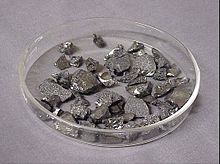Bor, 5 Tính chất chung Tên, ký hiệu Bor, B Phiên âm (BOR -on Hình dạng Đen nâu Bor trong bảng tuần hoàn
Số nguyên tử (Z ) 5 Khối lượng nguyên tử chuẩn (±) (A r ) 10,811(7) Phân loại á kim Nhóm , phân lớp 13 , p Chu kỳ Chu kỳ 2 Cấu hình electron [He] 2s2 2p1 mỗi lớp
2, 3 Tính chất vật lý Màu sắc Đen nâu Trạng thái vật chất Chất rắn Nhiệt độ nóng chảy 2349 K (2076 °C, 3769 °F) Nhiệt độ sôi 4200 K (3927 °C, 7101 °F) Mật độ ở thể lỏngở nhiệt độ nóng chảy: 2,08 g· cm−3 Nhiệt lượng nóng chảy 50,2 kJ· mol−1 Nhiệt bay hơi 480 kJ· mol−1 Nhiệt dung 11,087 J· mol−1 · K−1 Áp suất hơi
P (Pa)
1
10
100
1 k
10 k
100 k
ở T (K)
2348
2562
2822
3141
3545
4072
Tính chất nguyên tử Trạng thái oxy hóa 3 [1] Acid nhẹĐộ âm điện 2.04 (Thang Pauling) Năng lượng ion hóa Thứ nhất: 800,6 kJ·mol−1 −1 −1 Bán kính cộng hoá trị thực nghiệm: 90 pm Bán kính liên kết cộng hóa trị 84±3 pm Bán kính van der Waals 192 pm Thông tin khác Cấu trúc tinh thể Mặt thoi Hệ tinh thể lục phương (Tháp đôi ba phương) Vận tốc âm thanh que mỏng: 16,200 m· s−1 Độ giãn nở nhiệt (ß form) 5–7 [2] · m−1 · K−1 Độ dẫn nhiệt 27.4 W· m−1 · K−1 Điện trở suất ở 20 °C: ~106 Ω· m Tính chất từ Nghịch từ [3] Độ cứng theo thang Mohs ~9,5 Số đăng ký CAS 7440-42-8 Đồng vị ổn định nhất Bài chính: Đồng vị của Bor
Boron-10 tồn tại trong tự nhiên từ 19.1% đến 20.3%. [5]
Tham khảo Danh sách chú thích này sẽ không hiển thị trong bài viết mà sẽ hiển thị ở đề mục Tham khảo.
^ Zhang, K.Q.; Guo, B.; Braun, V.; Dulick, M.; Bernath, P.F. (1995). “Infrared Emission Spectroscopy of BF and AIF” (PDF) . J. Molecular Spectroscopy . 170 : 82. doi :10.1006/jmsp.1995.1058 . Bản gốc (PDF) lưu trữ ngày 11 tháng 1 năm 2012. Truy cập ngày 13 tháng 7 năm 2011 . Quản lý CS1: nhiều tên: danh sách tác giả (liên kết ) ^ Holcombe Jr., C. E.; Smith, D. D.; Lorc, J. D.; Duerlesen, W. K.; Carpenter; D. A. (tháng 10 năm 1973). “Physical-Chemical Properties of beta-Rhombohedral Boron”. High Temp. Sci . 5 (5): 349–57. Quản lý CS1: nhiều tên: danh sách tác giả (liên kết ) ^ Lide, David R. (ed.) (2000). Magnetic susceptibility of the elements and inorganic compounds, in Handbook of Chemistry and Physics (PDF) . CRC press. ISBN 0849304814 Bản gốc (PDF) lưu trữ ngày 12 tháng 1 năm 2012. Truy cập ngày 13 tháng 7 năm 2011 . Quản lý CS1: văn bản dư: danh sách tác giả (liên kết ) ^ a b “Atomic Weights and Isotopic Compositions for All Elements” . National Institute of Standards and Technology. Truy cập ngày 21 tháng 9 năm 2008 .
^ Szegedi, S.; Váradi, M.; Buczkó, Cs. M.; Várnagy, M.; Sztaricskai, T. (1990). “Determination of boron in glass by neutron transmission method”. Journal of Radioanalytical and Nuclear Chemistry Letters . 146 : 177. doi :10.1007/BF02165219 .

